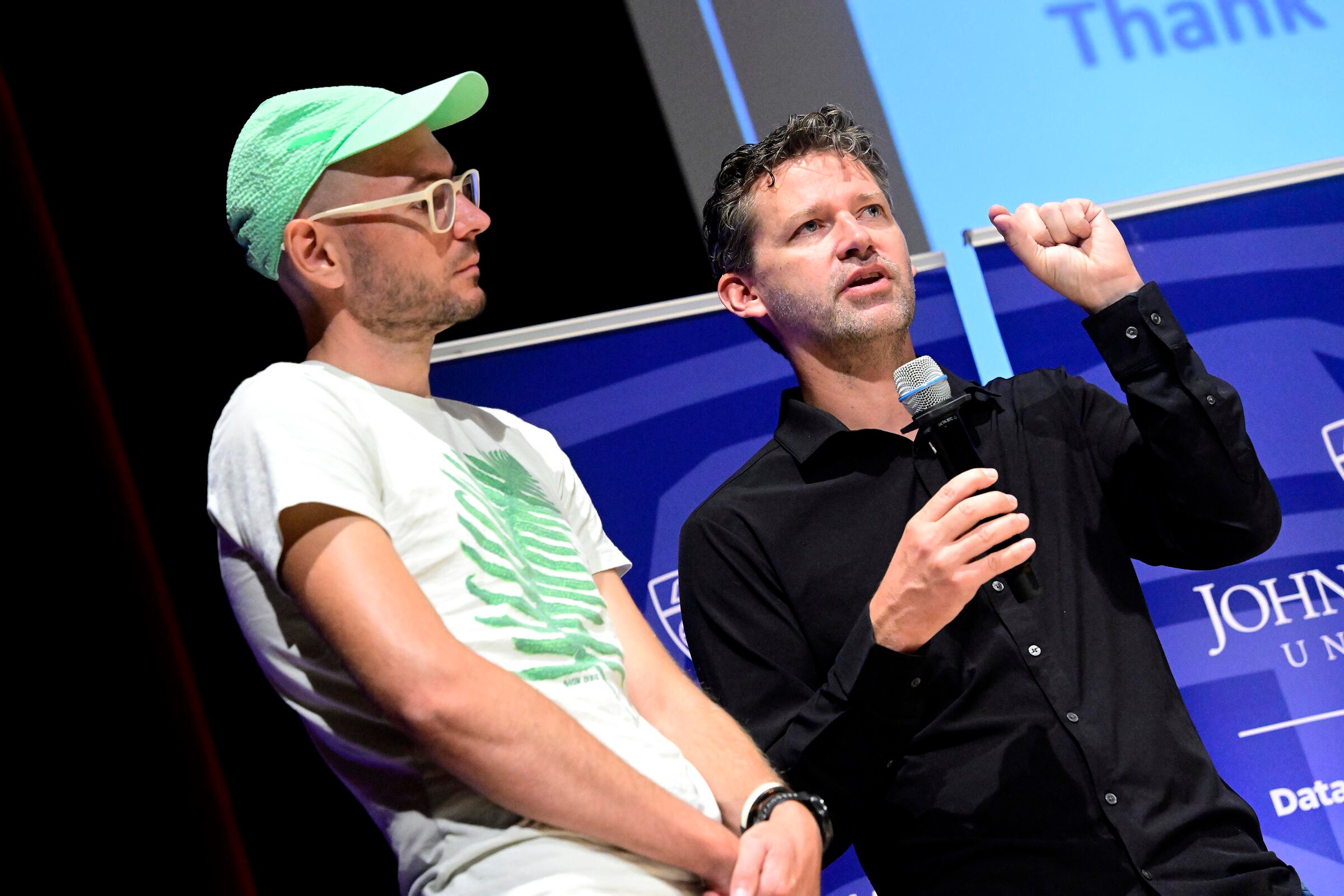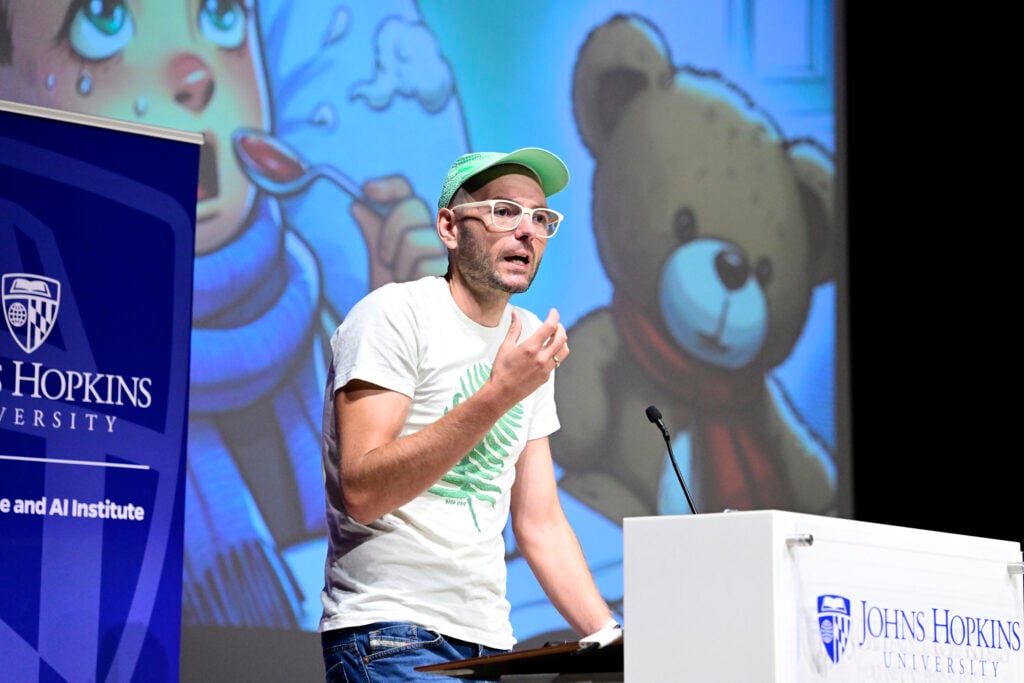It’s a conundrum: “By 2035, the number of surgeries performed in the United States is expected to double, yet our country already faces a major surgeon shortage,” mechanical engineer and Malone Center member Axel Krieger said at the Johns Hopkins Data Science and AI Institute’s fall symposium. “If we don’t do something about it, then 10 years from now, every surgeon will need to perform double the number of surgeries they’re already performing.
“This is a crisis,” he stressed.
Krieger, a member of the Data Science and AI Institute, or DSAI, and an associate professor in Johns Hopkins’ Whiting School of Engineering, is among the many engineers, computer and data scientists, medical researchers, and clinicians at Johns Hopkins leading the charge to ensure that crises like this don’t come to fruition. And at DSAI’s fall symposium—AI in Daily Life, held September 16 on the Homewood campus and open to the public—he and others presented what they’re doing to contend with the surgeon shortage and other pressing health-system challenges.
A builder of robots, Krieger and his colleagues are using artificial intelligence to develop “mechanical surgeons” that assist with and perform surgery—first on animals and lifelike artificial patients but eventually, his team anticipates, humans. His Smart Tissue Autonomous Robot, STAR, performed a laparoscopic surgery on a pig in 2022, in what was the world’s first autonomous robotic surgery on a live animal. Then, this past July, Krieger’s hierarchical surgical robot transformer, SRT-H, performed a lengthy and unprecedented 17-minute segment of a gallbladder removal surgery on a lifelike patient.
By design, the surgery involved spur-of-the-moment hitches in the operating room that mimicked real-life medical emergencies, Krieger said. But SRT-H rose to the challenge, responding flawlessly to voice commands and feedback delivered by humans, correcting itself, and adapting to the twists and turns that surgeons tend to encounter in the OR.
To train SRT-H, the robot watched videos of expert-level surgeons performing their complex trade. “And through that process, SRT-H demonstrated an ability to learn, grow, and self-correct in response to knowledge and information,” Krieger said about the federally funded project. “This is a huge step in robotic surgery.”
It will take time for robots (with guidance and assistance from humans) to perform surgeries across the country and around the world, but we’re on that trajectory, Krieger said.

Mathias Unberath and Axel Krieger. Image Credit: Will Kirk / Johns Hopkins University
Also presenting at the symposium was Mathias Unberath, DSAI’s director of research, interactive, and embodied AI and a John C. Malone Associate Professor of Computer Science with joint appointments in ophthalmology and otolaryngology at the School of Medicine.
“Seeking medical care [in the U.S.] usually comes with a ton of frustration,” Unberath told the crowd. “You don’t get the care where you need it—in your home—and you have to [make arrangements] to secure child care and travel to your doctor’s office, assuming your provider even has an open appointment.”
Unberath described the common scenario of waking up with a sore throat and not knowing whether it was strep, the contagious bacterial infection treated with antibiotics, or something like a seasonal cold that needed to run its course and would likely resolve on its own. “You wouldn’t want to spread strep at work or school,” he said. “And you’d want to feel better, so you’d need to know.”
To help, Unberath and his colleagues worked with Therese Canares, Bus ’21 (MBA), a pediatric emergency physician and entrepreneur, to develop a mobile app that serves as a strep-throat screening tool. Users simply upload a photo of their throat. The app then compares the photo to AI images and determines the likelihood of strep in a matter of seconds, offering guidance on self-care strategies and whether to see a doctor.
Dubbed CurieDx, the app is named after the two-time Nobel Prize-winning Polish-French scientist Marie Curie—a decision made by Canares, who put her clinical work on hold to bring the app to market and add more screening capabilities, say, for rashes and eye infections. Currently, doctors and nurses can use CurieDx in the clinic and via telehealth to help diagnose strep throat, and people everywhere will soon be able to use it at home or on the go, Unberath said.
According to Unberath, AI-based tools like this hold the potential to transform the medical system—in particular, by easing the burden on the health system at a time when chronic illnesses are rising, our population is aging, and physician and nurse shortages are leaving patients without the care they need, he said. Specialists like neurologists, psychiatrists, cardiologists, ophthalmologists, and others are especially in short supply, with patients sometimes waiting more than a year for an appointment, Unberath told the audience.
AI can help, he and others contended. For example, another AI-based device Unberath is developing equips general eye-care providers with the training and tools they need to detect glaucoma, a progressive condition and a leading cause of blindness. Typically, ophthalmologists who specialize in glaucoma make the diagnosis, but securing an appointment often involves a long wait time. With this new AI tool, general eye doctors will be able to spot glaucoma, gauge the severity, and start or manage a treatment regimen, while referring patients with fast-progressing or severe conditions to a specialist.
Image Caption: Mathias Unberath; Image Credit: Will Kirk / Johns Hopkins University
